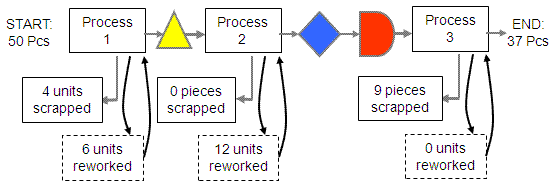Throughput Yield (TPY)
Also called 'First Pass Yield'
Throughput Yield (TPY) is the number of acceptable pieces at the end of the end of a process divided by the number of starting pieces excluding scrap and rework (meaning they are a part of the calculation).
Rework IS a part of the TPY calculation. Use the process map as a guide for evaluating each individual process.
TPY is used to only to measure a single process. This is another important concept that measures the efficiency of a process and use DPU as its base measurement.
Sometimes only raw material is available at the start so it may be necessary to convert the raw material to expected pieces that it should make, or use a unit of weight at the start and weight out at the end to calculate final yield.
The unit of measure must be the same for the numerator and denominator throughout.
Throughput Yield - Example
Calculation (assuming all rework only takes one time to correct):
Process 1 TPY:
40 of the 50 pieces that entered Process 1 went through Process 1 correctly the first time.
Therefore Process 1 TPY = 40 / 50 = 80.0%
Process 2 TPY:
34 of the 46 pieces that entered into Process 2 went through Process 2 correctly the first time through.
Therefore Process 2 TPY = 34 / 46 = 73.9%
Process 3 TPY:
37 of the 46 pieces that entered Process 3 went through Process 3 correctly the first time.
Therefore Process 3 TPY = 37/46 = 80.4%
NOTES:
Process 2 has the lowest throughput yield but not necessarily the most costs. If a scrapped piece in Process 3 has significantly more cost then Process 3 it may still be in the team’s best interest to improve. The later the process is downstream the more cost are accumulated in the piece or part.
There is more direct material, direct labor, and/or manufacturing overhead in each process as the part proceeds through its value stream. Process 3 at its initiation has all the costs in Process 2 + the costs of Process 1.
There is another method to calculate TPY for a single process. If the DPU or defects and units are known then:
Rework involves many of the 7-Wastes and contains the hidden factory opportunity, it is relevant to understand when guiding the team's direction.
Throughput Yield, TPY, and other yield metrics can serve as baseline scores (MEASURE phase) and final scores for Six Sigma projects (CONTROL phase).
The baseline score does not have to be a z-score and often this yield metrics are easier for team and other company employees to relate with and understand.
Other Process Yield Metrics
Return to BASELINE MEASUREMENTS
Search active Six Sigma related job openings
Templates, Tables, and Calculators
Site Membership
Click for a Password
to access entire site
Six Sigma
Templates & Calculators
Six Sigma Modules
The following are available
Click Here
Green Belt Program (1,000+ Slides)
Basic Statistics
Cost of Quality
SPC
Process Mapping
Capability Studies
MSA
Cause & Effect Matrix
FMEA
Multivariate Analysis
Central Limit Theorem
Confidence Intervals
Hypothesis Testing
T Tests
1-Way ANOVA
Chi-Square
Correlation and Regression
Control Plan
Kaizen
MTBF and MTTR
Project Pitfalls
Error Proofing
Effective Meetings
OEE
Takt Time
Line Balancing
Practice Exam
... and more



